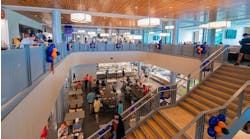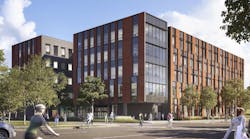Buildings must be designed to be flexible and adaptable to accommodate changes in learning and technology, and countless other factors. Rethinking the school building is necessary, but it is only part of the equation. Why not rethink the entire school campus as well? By careful site planning and by introducing outdoor learning centers — also called schoolyard ecosystems — schools can enhance the use of their grounds while adding a rich component to the academic program.
Schools continue to face shortages of space and money, and are likely to do so well into the future. Under such conditions, schools have to make the most of what they already have. If a building is too small, why not go outside the building? Students do not have to leave the campus to learn outside the classroom if those opportunities are made available on the school grounds.
With good design and creative programming, outdoor spaces can be effective learning environments, often at a fraction of the cost of constructing new indoor space. And while school sites often seem cramped and unable to take on more uses, this may be the result of poor planning and a lack of creative thinking rather than size. Activities like recess and athletic events cause intensive use for short periods, but most of the time school grounds are underused. Meanwhile, they require ongoing maintenance, such as mowing, cleaning and snow removal. It would make sense to devote the same attention, thought and resources that go into designing school buildings toward making school grounds more useful. This is true for college and university campuses, but particularly for K-12 campuses.
School campuses can provide opportunities in the most unattractive or neglected areas. An outdoor education center can transform a drainage gulch into a lab with an amphitheater and wildlife habitats, including a wildflower meadow and a miniature arboretum with native trees and shrubs. A creek running through the site can create a wetlands area with a small pond that collects and recirculates water. Paths can wind through an outcropping of red rock that mimics a renowned local geologic formation. These are just a few ideas that are feasible for schools.
Outdoor learning
Using the outdoors as a learning environment can expand educational opportunities. Students can observe the natural effects of time, weather and other forces on their campus. The philosophy of “building as teacher” applies even more to outdoor spaces.
The schoolyard is a great place for collaborative and interactive activities such as building, conducting science experiments and doing art projects. The outdoors usually is more accommodating than classrooms to collaboration and interaction. And it offers learning experiences that cannot be duplicated indoors. Planting a bird or butterfly garden, for example, teaches students about plants and life cycles, soil, growing conditions, and how insects, birds and other creatures interact.
Outdoor environments also can stimulate interest and curiosity. Most schoolyards are not mind-expanding environments. They tend to be bleak, sterile expanses of asphalt and grass, punctuated with playground equipment.
The outdoors offers so many dynamic possibilities that appeal to the interests and aesthetics of children. A series of adventures and ideas that relate to the history and culture of the place can be incorporated into the design of an outdoor learning center. Features such as bridges and stepping stones, as well as hidden, protected places where students can discover plants and rocks, share secrets, and observe animals and birds, can foster imagination.
Serving the whole community
Many lifelong skills are conveyed in the schoolyard. It can serve as a place where the community can gather and learn through organized and informal activities, such as festivals, neighborhood picnics and sports events. With appropriate gathering places — such as an entrance lawn with a shady reading courtyard and benches — the schoolyard becomes a welcoming point for the neighborhood. Parents and others can visit with each other and school staff before or after school. Families can use the school grounds after school for activities with friends and neighbors.
If a campus is inhabited throughout the day by community members, there are more eyes on activities there — an element that has been proven to reduce crime in parks and other public areas.
Campus and building spaces also can be linked visually so that classrooms and administrative areas of the building look out onto an active and attractive learning environment. This facilitates supervision while enhancing the views from within the building.
More secure spaces can be created with enclosed courtyards and patios, but these places must be designed and programmed carefully or they will become wasted space. It is their openness and connection to the greater environment that makes outdoor learning spaces most effective.
Transforming the schoolyard
To expand classrooms beyond the school buildings' walls, begin by thinking about and planning for outdoor spaces with the people who will use them — staff and students. Campuses can be made useful and attractive beyond the usual playfields, parking and dining patios.
For example, outdoor learning areas might include a nature trail, a community garden or an art space with tables, sinks and gallery space. A stage or amphitheater can be created for performing-arts classes and lectures.
Climate control is as necessary in the outdoor classroom as it is indoors. Outdoor classrooms can be protected from rain, wind and sun by berms, trees and shrubs, and architectural features such as covered pergolas.
Outdoor classrooms do not have to be low-tech — they can be equipped with electricity and data ports — but the design has to be thought out clearly.
Although they might be less costly to build than comparable indoor spaces, outdoor classrooms still cost money, and should be adequately funded. Many schools raise funds and obtain grants and donated time and materials to build outdoor learning areas.
If taken seriously and executed properly, outdoor learning environments can make wiser use of entire school sites and open up a new world of possibilities for school communities.
Layton is a principal of Design Concepts, a community and landscape architecture firm in Lafayette, Colo.
One step further
To learn more about outdoor learning environments, here are some options:
-
A landscape architecture and planning firm in your region with creative experience in campus design.
-
Your state department of natural resources or state wildlife agency.
-
Resources for Global Sustainability, www.environmentalgrants.org, which publishes Environmental Grantmaking Foundations 2001, a guide to top environmental foundations. Including mailing, it costs $105 in print and $115 on CD-ROM. Contact [email protected]; P.O. Box 3665, Kary, North Carolina 27519; (800)724-1857.
-
North American Association for Environmental Education, www.naaee.org, a professional network of educators that provides publications and grants. Contact at [email protected]; 410 Tarvin Road, Rock Spring, GA 30739; (706)764-2926.

